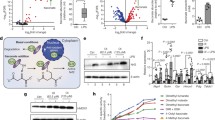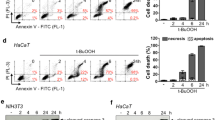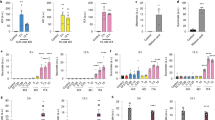Abstract
Although it is generally believed that reactive oxygen species activate NF-κB, a primary oxidative stress-responsive transcription factor, it is unclear which one among these species causes NF-κB activation. Our hypothesis is that hydroxyl radical (·OH) functions as a messenger for the activation of NF-κB. Jurkat cells, macrophages and JB6 cells were used to test this hypothesis. Cr(VI), silica and ZnO were used as sources of ·OH radicals. None of these ·OH generating systems involves exogenous H2O2. Cr(VI) expressed enhanced activity in induction of NF-κB in Jurkat cells. This activation of NF-κB was decreased by a metal chelator, diethylene triaminepentaacetic acid or a H2O2 scavenger, catalase, but was increased by superoxide dismutase. Mn(II), which reacts with Cr(IV) to inhibit this metal ion-mediated ·OH generation, decreased the NF-κB activation. Sodium formate, an ·OH radical scavenger, also inhibited the NF-κB activation. Electron spin resonance measurements show that Cr(VI) was reduced by Jurket cells to Cr(IV) and Cr(V). During the reduction process, molecular oxygen was reduced to O2- and then to H2O2, which reacted with Cr(IV) and Cr(V) to generate ·OH radical. The ·OH generation correlated with the Cr(VI)-induced NF-κB activation. Similarly, silica caused NF-κB activation in macrophages via the ·OH radical-mediated reaction. This radical was generated via metal mediated reaction from H2O2, which was generated by the reduction of molecular oxygen via O2- as an intermediate during the silica-stimulated ‘respirable burst’. Silica particles did not cause ·OH generation either in Jurket or in JB6 cells and thus did not cause any observable NF-κB activation in these cells. ZnO induced NF-κB activation in JB6 cells through the generation of ·OH resulting from light irradiation of ZnO which was measured by electron spin resonance. The results thus show that ·OH radical functions as a messenger for NF-κB activation. Antioxidants, which scavenge ·OH radical or its precursors, inhibit NF-κB activation. Metal chelators, which make metal ions incapable of generating ·OH from H2O2, inhibit activation of this transcription factor.
Similar content being viewed by others
References
Baeuerle PA, Henkel T: Function and activation of NF-κB in the immune system. Annu Rev Immunol 12: 141–179, 1994
Baldwin AS: The NF-κB and IκB proteins: New discoveries and insights. Annu Rev Immunol 14: 649–681, 1996
Schreck R, Alberman K, Baeuerle PA: Nuclear factor κB: An oxidative stress-responsive transcription factor of eukaryotic cells (a review). Free Rad Res Commun 17: 221–237, 1992
Sun Y, Oberley LW: Redox regulation of transcriptional activators. Free Rad Biol Med 21: 335–348, 1996
Sen CK, Packer L: Antioxidant and redox regulation of gene transcription. FASEB J 10: 709–720, 1996
Suzuki YJ, Forman HJ: Oxidants as stimulators of signal transduction. Free Radical Biol Med 22: 269–285, 1997
Schreck R, Rieber P, Baeuerle PA: Reactive oxygen intermediates as apparently widely used messengers in the activation of the NF-κB transcription factor and HIV-1. EMBO J 10: 2247–2258, 1991
Meyer M, Schreck R, Baeuerle PA: H2O2 and antioxidants have opposite effects on activation of NF-κB and AP-1 in intact cells: AP-1 as secondary antioxidant-responsive factor. EMBO J 12: 2005–2015, 1993
Freemam BA, Crapo JD: Biology of disease: Free radicals and tissue injury. Lab Invest 47: 412–426, 1982
Schmidt KN, Amstad P, Cerutti P, Baeuerle PA: The role of hydrogen peroxide and superoxide as messengers in the activation of transcription factor NF-κB. Curr Biol 2: 13–22, 1995
Schulze-Osthoff, K, Beyaert R, Vandevoorde V, Haegeman G, Fiers W: Depletion of the mitochondrial electron transport abrogates the cytotoxic and gene-inductive effects of TNF. EMBO J 12: 3095–3104, 1993
Schulze-Osthoff K, Bakker AC, Vanhaesebroeck B, Beyaert R, Jacob WA, Fiers W: Cytotoxic activity of tumor necrosis factor is mediated by early damage of mitochondrial functions. Evidence for the involvement of mitochondrial radical generation. J Biol Chem 267: 587–592, 1992
Schreck R, Baeuerle PA: Oxygen radicals as mediators in the activation of inducible eukaryotic transcription factor NF-κB. Meth Enzymol 234: 151–163, 1994
Israel N, Gougerot-Pocidalo MA, Aillet F, Virelizier JL: Redox status of cells influences constitutive or induced NF-kappa B translocation and HIV long terminal repeat activity in human T and monocytic cell lines. J Immunol 149: 3386–3393, 1992
Anderson MT, Staal FJT, Gitler C, Herzenberg LA: Separation of oxidant-initiated and redox-regulated steps in the NF-κB signal transduction pathway. Proc Natl Acad Sci USA 91: 11527–11531, 1994
Suzuki YJ, Mizurto M, Packer L: Transient overexpression of catalase does not inhibit TNF-or PMA-induced NF-kappa B activation. Biochem Biophys Res Commun 210: 537–541, 1995
Sies H: Strategies of antioxidant defense. Eur J Biochem 21: 213–219, 1993
Ye J, Zhang X, Young HA, Mao Y, Shi X: Chromium(VI)-induced nuclear factor-κB activation in intact cells via free radical reactions. Carcinogenesis 16: 2401–2405, 1995
Dong Z, Craw HC, Lavrovsky V, Taub D, Watts R, Matrisian LM, Cobburn NH: A dominant negative mutant of jun blocking 12-o-tetradecanoylphorbol-13-acetate-induced invasion in mouse keratinocytes. Mol Carcinogenesis 19: 204–212, 1997
Sun SC, Elwood J, Beraud C, Greene WC: Human T-cell leukemia virus type I Tax activation of NF-kappa B/Rel involves phosphorylation and degradation of I kappa B and RelA(p65)-mediated induction of the c-rel gene. Mol Cell Biol 14: 7377–7384, 1994
Shi X, Dalal NS: On the hydroxyl radical formation in the reaction between hydrogen peroxide and biologically generated chromium(V) species. Arch Biochem Biophys 277: 342–350, 1990
Shi X, Mao, Y, Knapton AD, Ding M, Rojanasakul R, Gannett PM, Dalal NS, Liu KJ: Reduction of Cr(VI) with ascorbate and hydrogen peroxide generates hydroxyl radicals and causes DNA damage: Role of a Cr(IV)-mediated Fenton-like reaction. Carcinogenesis 15: 2475–2478, 1994
Shi X Dalal NS: Role of superoxide radical in chromium(VI)-generated hydroxyl radical: The Cr(VI) Haber-Weiss cycle. Arch Biochem Biophys 292: 325–327, 1992
Buettner GR: ESR parameters of spin adducts. Free Rad Biol Med 3: 259–303, 1987
Vallyathan V, Shi, X, Dalal NS, Irr W, Castranova V: Generation of free radical from freshly fractured silica dust. Potential role in acute silica-induced lung injury. Am Rev Resp Dis 138: 1213–1219, 1988
Vallyathan V, Mega JF, Shi X, Dalal NS: Enhanced generation of free radicals from phagocytes induced by mineral dusts. Am J Resp Cell Mol Dis 6: 404–413, 1992
Chen F, Sun SC, Kuh DC, Gaydos U, Demers LM: Essential role of NF-κB activation in silica-induced inflammatory mediator production in macrophages. Biochem Biophys Res Commun 214: 985–992, 1995
Chen F, Kuh DC, Sun SC, Gaydos U, Demers LM: Dependence and reversal of nitric oxide production on NF-KB in silica and lipopolysaccharide-induced macrophages. Biochem Biophys Res Commun 214: 839–846, 1995
Shi X, Dalal NS: NADPH-dependent flavoenzymes catalyze one electron reduction of metal ions and molecular oxygen and generate hydroxyl radicals. FEBS Lett 276: 189–191, 1990
Ji L, Arcinas M, Boxer LM: NF-kB sites function as positive regulators of expression of the translocated c-myc allelle in Burkitt's lymphoma. Mol Cell Biol 14: 141–179, 1994
Author information
Authors and Affiliations
Rights and permissions
About this article
Cite this article
Shi, X., Dong, Z., Huang, C. et al. The role of hydroxyl radical as a messenger in the activation of nuclear transcription factor NF-κB. Mol Cell Biochem 194, 63–70 (1999). https://doi.org/10.1023/A:1006904904514
Issue Date:
DOI: https://doi.org/10.1023/A:1006904904514




